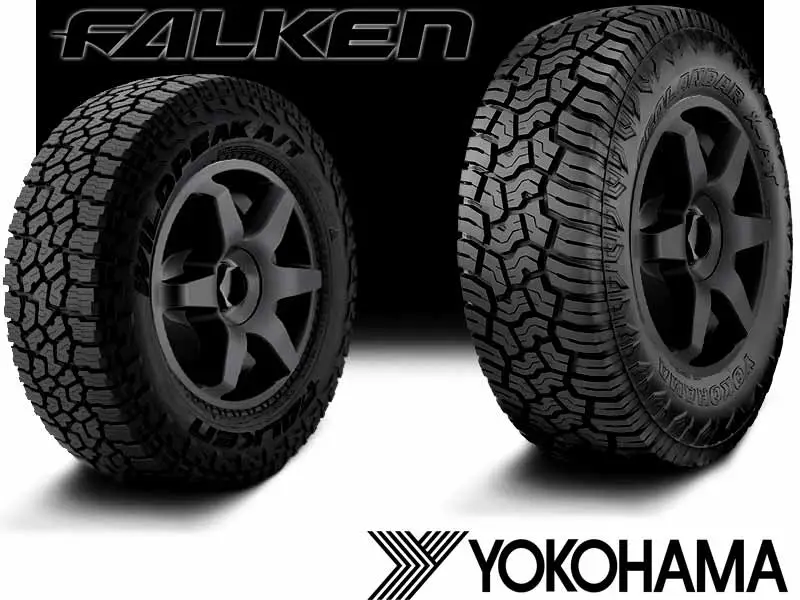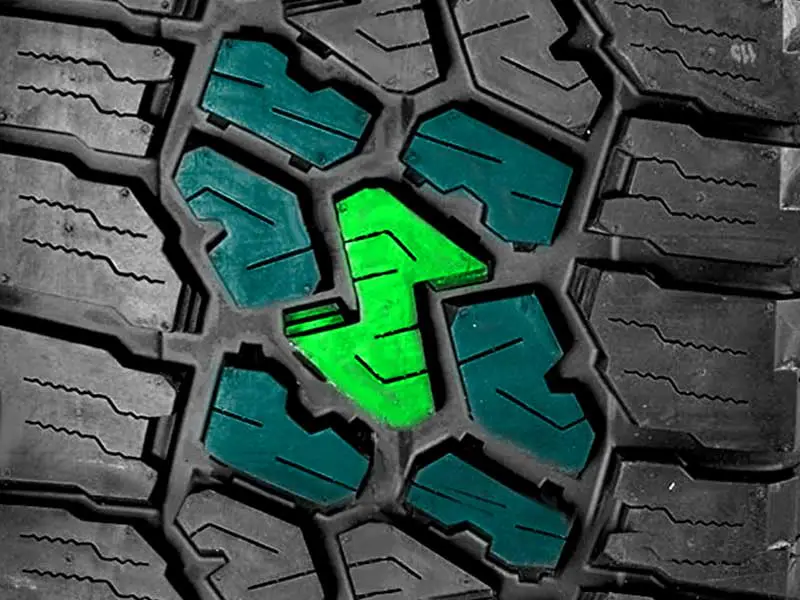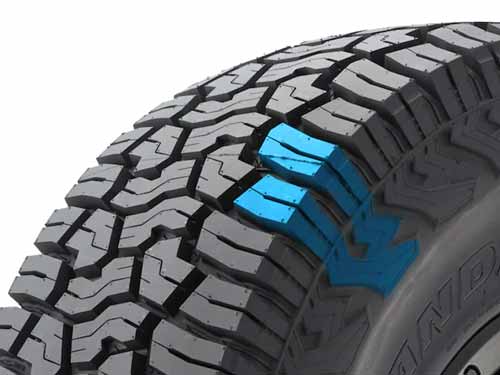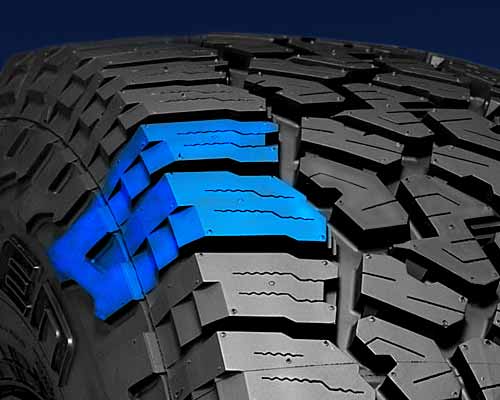Yokohama Geolandar X AT vs Falken Wildpeak AT3W: Both Yokohama Geolandar X AT and the Falken Wildpeak AT3W are all terrain tires which provide you with a lot of features that make them capable of taking on some rugged off road challenges while staying calm on roads.
The Yokohama Geolandar X AT provides great off road performance, while the Falken Wildpeak AT3w provides amazing lateral traction values which helps it with cornering stability on both wet and dry pavements.

Examine the treads on these tires closely. They hold the key to knowing which to choose. In fact if you visit my "tread design" page, picking the right tire would never bother you.
Table of Contents
Tread Appearance:
Yokohama Geolandar X-AT, simply put is a more aggressive tire in comparison. Besides AT, the X added to its name indicates that it’s a more rugged tire built on an all terrain platform.
Falken Wildpeak AT3w

Yokohama G016 X/AT

The tire offers 2 unique blocks, where on pattern the other form mirror images of each other. Both groups are highlighted with blue and red, below.

All these blocks have reinforced foundations underneath and they carry similar features of notches and rectilinear sipes, although the blue ones also make notches on the sides as well.
On the other hand, in case of Falken Wildpeak AT3w, the tire offers blocks where you can see stepped edges on sides, and notches on the surrounding blocks.

Also like the Yokohama Geolandar XAT, the tire makes 2 large circumferential grooves, though not as wide as it’s competitor.
If we look at the shoulder blocks of both tires, the Yokohama XAT offers a less aggressive design here in comparison (which seems odd).

The tire barely makes staggered shoulder blocks and the scoops are very less prominent.
Blocks have deep slits (on outer edges) but very less siping (these slits do nothing for wet traction, by the way, as you’ll see in the wet traction section below).
But the tire does make wider lateral grooves between the shoulder blocks, and have stone ejectors in them unlike the Falken AT3w.
But still Wildpeak make very rugged outer edges.

Besides having numerous sipes and notches on the inner edges, the tire forms stepped edges towards the sidewalls.
Each shoulder block is actually staggered on itself, and this provides this tire with great biting ability.
The U shaped sidewall lugs are also more effective off roads, especially on rocky terrains (during sidewall flexing).
Durability:
Yokohama Geolandar X-AT offers 3 ply polyester carcass, which they call Geo Shield. These 3 layers are piled up with 2 steel belts and this is further packed with full width cap of nylon covering the whole tread area and slightly on out skirts of shoulders.
On the other side, the Falken Wildpeak provides regular 2 ply polyester casing, 2 belts but here it’s topped with 2 layers of nylon.
The tire also provides 2 extra layers just for the sidewall protection. These polyester layers run around the tire’s bead.
So overall, both tires are rated almost equal in case of durability. And they’ll provide good deal of puncture resistant off road.
Furthermore, their rubber compound is also made from chip and cut resistant material, so this also adds to toughness.
Side Note: Yokohama Geolandar XAT and BF Goodrich KO2, both provide similar durability.
Dry Roads performance:
The overall dry performance of the tires depend on a lot key areas, and out of them, grip, lateral traction and steering response are the most crucial.
The Yokohama Geolandar X-AT is actually a rugged terrain tire, so the tire with wider grooves compromises on contact patch with the road and this limits the tire’s grip.
But that’s just a tiny part of the problem. The major issue with this tire is it’s weight (due to its heavier construction) and because of this, the handling becomes a little clumsy.
Also with heavier construction, and softer rubber, the tire also manufactures larger rolling resistance, and this burns out the tire’s tread faster. Still Yokohama offers a warranty of 45k miles on it (Falken provides 55k).
On the other hand, the Falken Wildpeak AT3w, provides great on road mannerisms. It’s notches and stepped edges provide the blocks with rigidity, which is further enhanced by supporting ridges, so during cornering and braking, it shows remarkable stability.
Comfort and Noise:
Noise is just air either passing through the tread or hitting it. And, with Yokohama XAT, the wider grooves provide a lot of room for air to come in and strike against the tread. That’s why the tire is very loud.
But it would have been louder, if it’s company wouldn’t have implemented variable pitch technology in it’s tread.
On the other side, Falken Wildpeak AT3w is one of the quietest tires you can get (which is this aggressive as well), this is because, it’s prevents air to come in and hit the walls too vigorously.
Most of the noise/air comes through the shoulders, and Wildpeak with restricted lateral spacing between the blocks, limit the amount that can pass through.
Furthermore, these lateral spacing also have ridge in between, so this further restricts the passing air, reducing overall tread noise.
Wet Traction:
The wet grip on Yokohama Geolandar X-AT is not impressive at all, as the tire severely lacks in total number of siping.
Although it’s a good trade off for better off road performance, it compromises on wet lateral traction. In other words, the tire is prone to slippage on sides.
And this also dampens down the overall handling performance, as well.
In comparison, the Falken Wildpeak provides better handling times and wet grip (shorter braking distances) by a huge margin.
It offers dual siping design where on shoulders it’s more interlocking, which is very effective in clearing water away from it’s path.
Hydroplaning:
Hydroplaning is another important component of wet traction, and it measures how fast a tire can clear water from it’s grooves.
And both tires show up with decent float speeds, on both straight and curved roads.
(Float speed is just the maximum speed a tire can roll over water without “floating”).
And both tires provide a good real estate of channels for water to pass through, where Falken Wildpeak AT3w provides you with deeper grooves, while the Yokohama Geolandar XAT has wider tread voids.
Winter Traction Performance:
Yokohama Geolandar X-AT is not 3 peak mountain snowflake rated. The tire does not offer enough biters to grab the snow particles.
Moreover, it’s minimal siping design also decreases the tire’s traction abilities, especially on ice.
The Falken Wildpeak provides better snow biters, which hangs on to the snow particles and this way the tire makes better snow to snow contact (which is what you need in winter traction, that’s why all winter tires offer this feature).
It’s also branded with 3 peak mountain snowflake rating.
Mud Performance:
Mud is not an issue with Yokohama Geolandar X-AT. The tire is technically a light mud tire. It offers very wide channels of grooves for mud to evacuate.
It’s stone ejectors surrounding the shoulder blocks also aid in breaking down the mud particles.
But as aggressive as the tire is, it sure doesn’t make aggressive enough mud scoops on the sides. In other words, its shoulder blocks are barely staggered, where very small traction scoops are seen.
Nonetheless, the tire shows better performance here overall.
The Falken Wildpeak AT3w on the other hand, does not offer wider channels for mud to effectively evacuate. And on sides, the tire only has stepped edges and there are no prominent concave-shaped scoops, so it lacks here to it’s competitor.
Performance on Rocks:
On rocky terrains, the tire’s sides are very significant both internally and from outside.
Now, the Yokohama Geolandar X-AT provides durable enough inner construction, and it’s sidewalls can take on rugged off road abuse, but outside, the tire does not offer effective lugs.
They are not aggressive enough, so they don’t provide larger footprint to grab the rocky surface,(especially when you run them with lowered pressure).
In comparison, the Falken Wildpeak provides thicker U shaped lugs, which offer preferable biting power.
Sand Performance:
As we talked about above, the lugs on Yokohama Geolandar X-AT provide almost similar foot print compared to it’s competitor, so when pressured down, both tires would be providing similar traction.
But on sandy terrain, digging is something which is not preferred.
So as Falken Wildpeak with it’s saw toothed edges dig more, the tire faces a tougher time going through. In comparison, the Geolandar XAT has better forward-moving aid.
Summing up:
Yokohama Geolandar X-AT comes in the category of hybrid/rugged terrains, but the tire’s shoulders are not aggressive enough, so it lacks in lateral traction.
But other than that, the tire is great off road and has a durable 3 ply polyester construction.
On the other hand, Falken Wildpeak AT3w shows better on road performance by a large margin. The tire is also pretty neat off road and excels in snow traction with 3 peak mountain snowflake rating.



